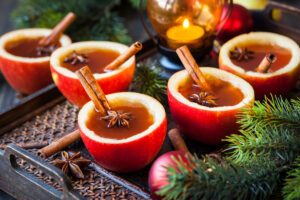
Traditionally, holidays are times when families, friends, and communities come together, with food playing an essential role in celebrations. In New York City, people from many different cultures celebrate the winter holidays with unique foods. It is impossible in a short blog post to even “give a taste” of the diverse dishes being served this season. Here are just a few holiday highlights, as well as a selection of e-cookbooks available through the library.
Christmas:
Many New Yorkers from different cultural backgrounds will soon celebrate Christmas Eve and Christmas with big, multi-course feasts. One of the most elaborate is The Feast of the Seven Fishes, an Italian-American Christmas Eve celebration. It may include seven or more specific fish dishes, such as whiting in lemon, clams in spaghetti, or baccalà (dried, salted cod). If you ever want to try to create your own feast, there are several pesci recipes in Canal House Cooking: Pronto! for you to try.
Filipinos celebrate Christmas from December 16 until the first Sunday of January and the Feast of the Three Kings. After Christmas Eve midnight mass, preparation begins for Noche Buena, when family, friends, and neighbors drop by for an open house celebration. Food is often served in buffet style. Among the typical foods prepared are lechon (roasted pig), queso de bola, ham, spaghetti, and fruit salad. Filipino Family Cookbook : A Treasury of Heirloom Recipes and Heartfelt Stories is a great resource if you’d like to learn more.
For many Latinos in the United States, the holiday season is synonymous with tamales. Mexican Americans often opt for corn-husk-wrapped tamales, while those from Central America typically wrap theirs in banana leaves. And while most Mexican and Central American tamales contain corn-based masa, Puerto Rican pasteles don’t use any, instead using a combination of ground yautía (yuca) and green plátanos (plantains). Tamales, Comadres, and the Meaning of Civilization is filled with family recipes and stories. It also celebrates tamaladas, large family gatherings to prepare the Christmas tamales.
There are many special desserts traditionally made at Christmas, such as German Stollen, Spanish Turrón, French Bûche de Noël, and Italian Panettone and Struffoli. The United States is best known for its varied Christmas cookies that reflect America’s immigrant heritages. City Tech Professor Michael Krondl is a culinary historian and the author of Sweet Invention: A History of Dessert. You can listen to his interview on The Takeaway about the history of Christmas cookies. For your own holiday cookie baking, take a look at The Great Minnesota Cookie Book : Award-Winning Recipes from the Star Tribune’s Holiday Cookie Contest.
Kwanzaa:
Kwanzaa is not a religious holiday nor a substitute for Christmas, and many people celebrate both across North America and the Caribbean. Maulana Karenga founded the weeklong festival in 1966 as a way for African-Americans to celebrate their families and communities, while honoring ancestors. The holiday is based on seven guiding principles, one for each day of the observance: unity, self-determination, collective work and responsibility, cooperative economics, purpose, creativity, and faith.
Celebrations begin by lighting candles, giving gifts, and decorating with the African colors of red, green, and black. Throughout the week, favorite African-American dishes, as well as traditional African and Caribbean favorites, are served.
The largest meal—Karamu Ya Imani—is held on December 31. The main dish served tends to be a stew, such as Ghanaian groundnut stew, Cajun jambalaya, Creole gumbo, or West Indian curry. Other classics include Hoppin’ John, Nigerian jollof rice, fritters, catfish, collard greens, fried okra, spoonbread, plantains, and (are you hungry yet?) sweet potato pie. Celebrate Vegan: 200 Life-Affirming Recipes for Occasions Big and Small offers delicious vegan versions of traditional soul food dishes. The Real Jerk : New Caribbean Cuisine provides recipes for Caribbean classics like jerk chicken, sorrel punch, and rum cake. Desserts might include soul food favorites like sweet potato pie, peach cobbler, or caramel cake. Global Bakery has recipes for delicious cakes from Africa and the Caribbean perfect for Kwanzaa, including Ginger Cake, Rum Cake, and Semolina Cake.
Michael Twitty is a wonderful food historian and writer who identifies as “an African American who happens to be Jewish, or a Jew who happens to be African American.” He writes a little about Christmas but he writes much more about Hannukah and Kwanzaa. His blog is a rich resource for both recipes and food histories.
Hannukah
Hannukah occurred in late November in 2021 due to the Jewish calendar’s use of a leap month, which is needed since it is a lunar calendar. Although Hannukah has passed, it’s not too late to enjoy the delicious traditional dishes served in Jewish communities.
Hannukah is an eight-day festival of lights commemorating the miracle when—after the Second Temple was desecrated then rededicated—one day’s worth of sacred oil for the altar’s eternal lamp lasted eight days. The eight-night celebration of Hanukkah is therefore supposed to include fried foods at the festive meal that is preceded by lighting the menorah, a eight- or nine-branched candelabrum. In Central and Eastern Europe, latkes (potato pancakes) were fried in schmaltz (poultry fat) because potatoes were plentiful while December was the season for slaughtering goose and ducks. Today, many people choose to make their latkes with vegetable oil.
Other Hanukkah foods reflect the ethnic diversity of Judaism. For example, Sephardic Jews (Mediterranean Jews) prepare elaborate vegetarian dishes with cheese while many Ashkenazi (Eastern European) Jews eat roasted brisket as a main dish.
Jelly donuts, or sufganiyot, another food deep-fried in oil, are a Hanukkah tradition from Israel popular with Americans. Jalebi, a treat enjoyed by Iraqi Jews, is basically a funnel cake, made out of a flour-based dough then deep fried and soaked in a sugar syrup. One exception to fried desserts is rugelach, an Eastern European pastry, which are crescent-shaped dough cookies filled with fruit preserves, poppy seeds, or chocolate and nuts. Hanukkah Sweets and Treats is a kid-friendly introduction to making these and more. The Kosher Baker is an excellent resource for dairy-free desserts.
Happy Winter Holidays!
This post was co-authored by Monica Berger.



